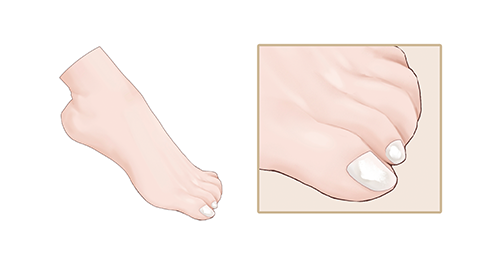What causes ingrown nails?
Generally speaking, when a nail grows into the flesh, it refers to an ingrown nail. Ingrown nails may be caused by improper trimming, inappropriate footwear, trauma, paronychia, or congenital toe nail deformities. If any discomfort occurs, seek medical attention promptly and undergo symptomatic treatment under the guidance of a qualified physician. Detailed analysis is as follows:

1. Improper Trimming
Trimming nails too short, especially cutting the edges too deeply, can easily cause newly grown nails to embed into the soft tissue, forming an ingrown nail. When trimming nails, one should leave the nail edges slightly beyond the fingertip, avoid trimming them into an arc or cutting too deeply on either side, and maintain a straight shape of the nail.
2. Inappropriate Footwear
Wearing tight, narrow, high-heeled, or pointed shoes for prolonged periods can compress the toes, forcing the nails to grow into the flesh. It is recommended to choose loose, comfortable shoes and avoid wearing tight or high-heeled shoes for long periods, allowing sufficient space for the toes.
3. Trauma
Toe injuries such as impacts or compression may cause nail deformation or embedment into the soft tissue. Patients may also experience symptoms such as swelling and bruising. For minor injuries, local cold compresses and elevating the affected limb can help reduce swelling; if the nail is severely embedded, surgical treatment is required.
4. Paronychia
Paronychia is usually caused by microbial infections, such as bacteria or fungi, affecting the nail fold tissue. The infection may cause swelling of the nail fold tissue, making the nail edges more likely to embed into the soft tissue. Symptoms may include pain and redness or swelling. Under a doctor's guidance, medications such as erythromycin ointment, fusidic acid cream, or clotrimazole cream may be used for treatment.
5. Congenital Toe Nail Deformities
Genetic factors may lead to abnormal nail shape or growth patterns, resulting in the above-mentioned conditions. Symptoms such as pain and difficulty walking may also occur. Patients can undergo nail correction surgery under a doctor's guidance. The surgical procedure may involve removing necrotic tissue and reshaping the toenail to restore its normal appearance and function.
In daily life, it is important to trim nails correctly and maintain an appropriate nail length, avoiding trimming them too short or cutting too deeply on either side. Regularly inspect the condition of the toes, and seek medical attention promptly if any abnormalities are noticed.






